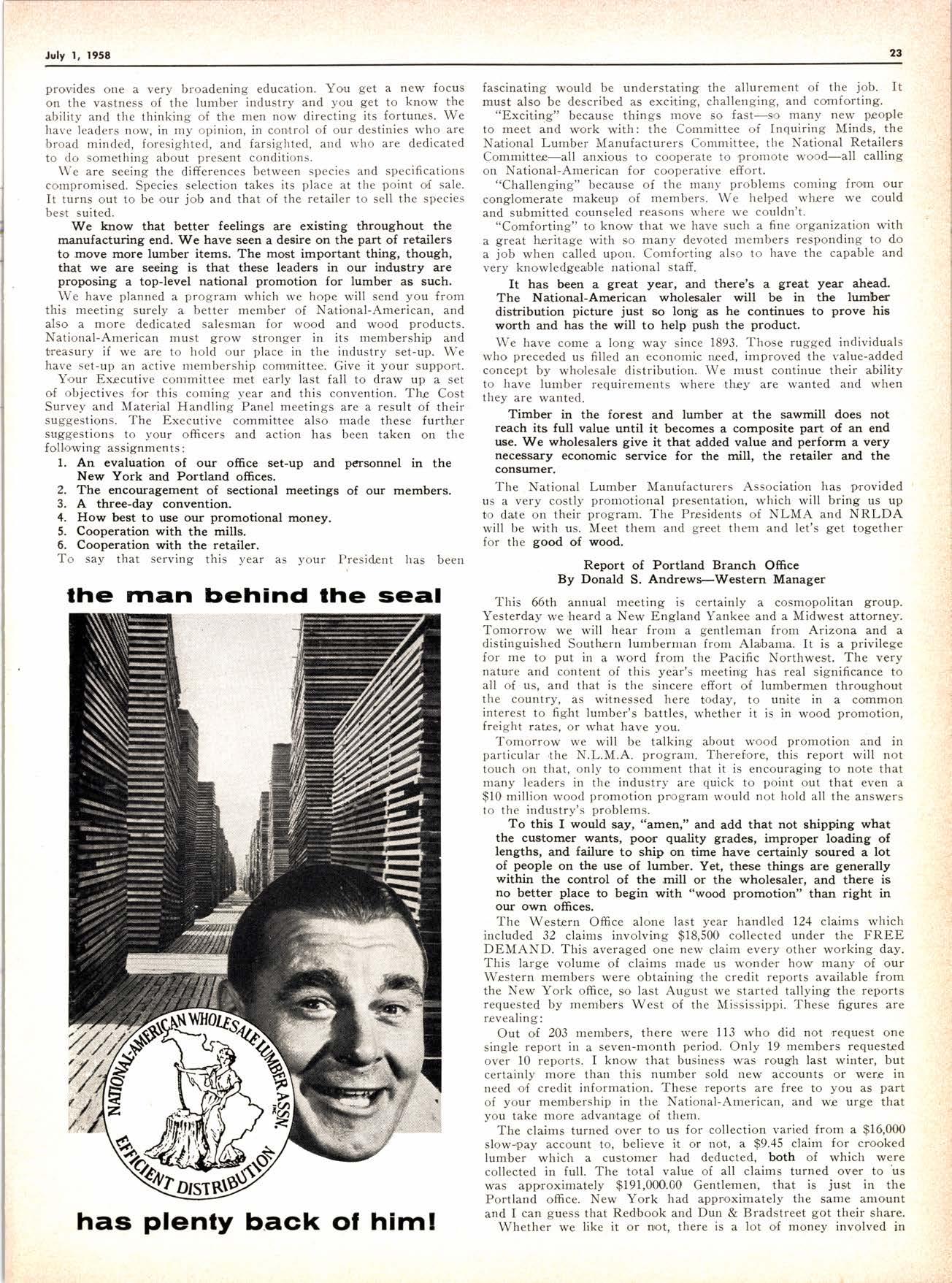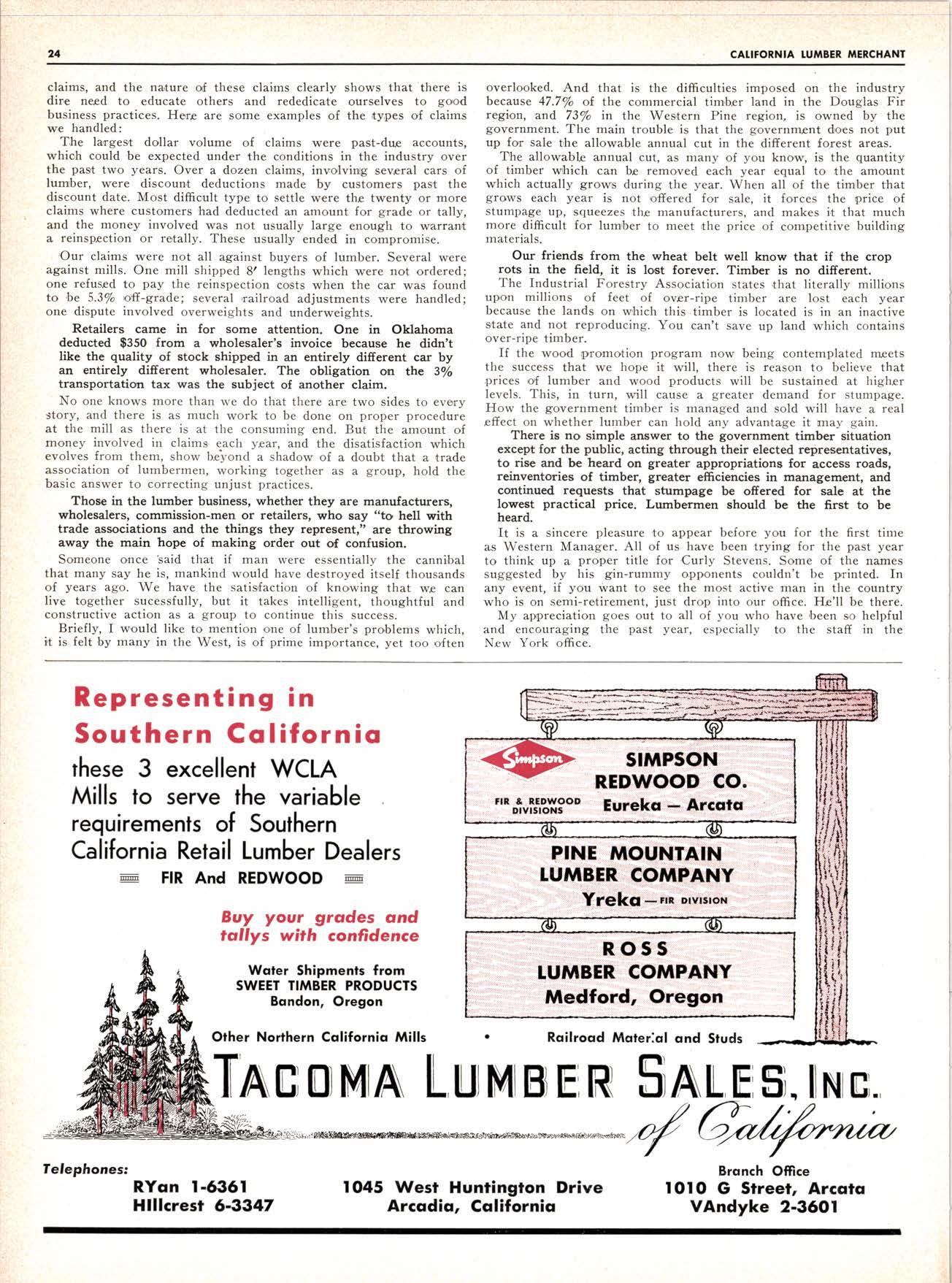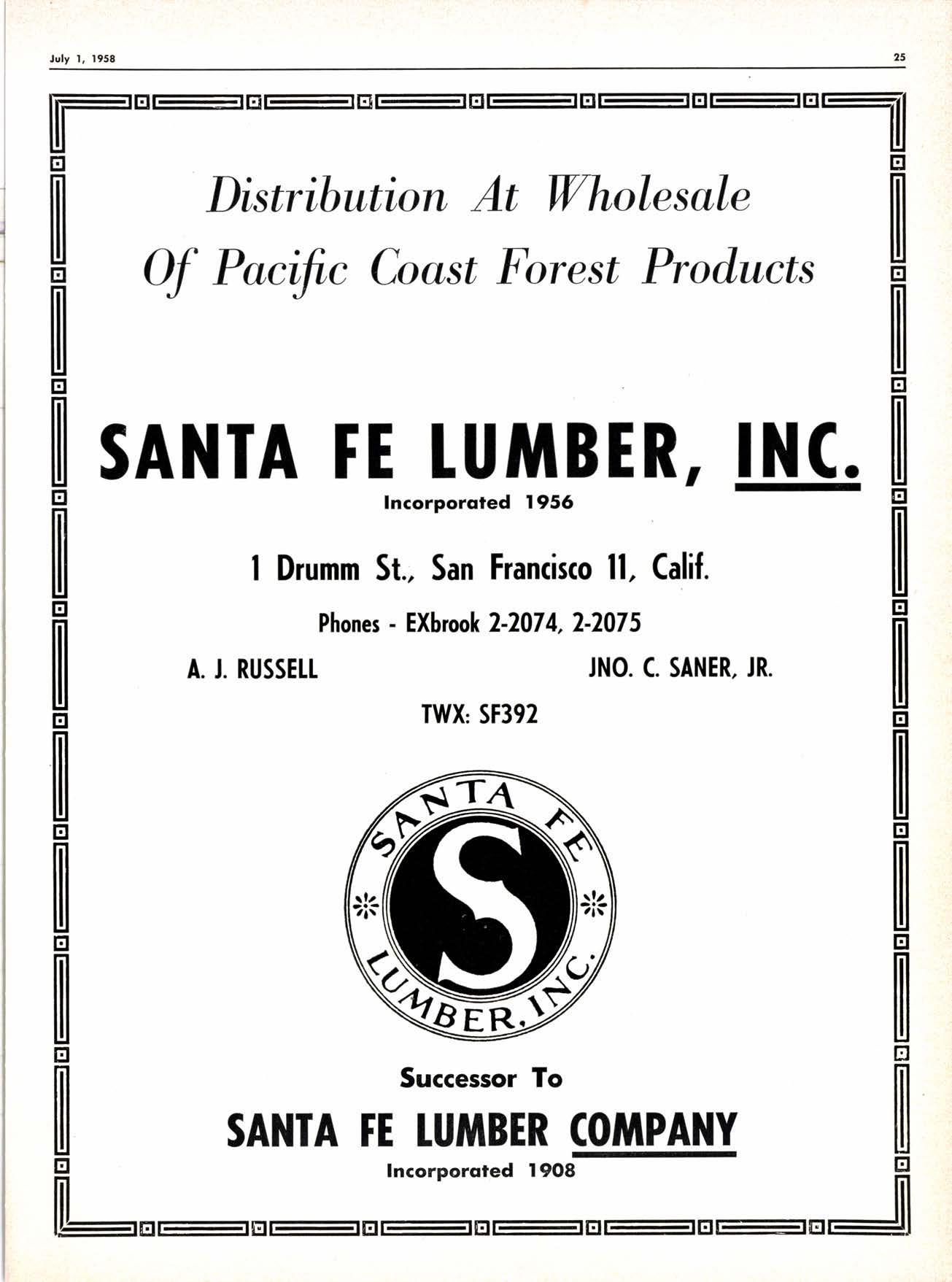
6 minute read
lhe lrran behind the seal
fascinating would be understating the allurement of the job. It must also be described as exciting, challenging, and comforting.
"Excit'ing" because things move so fast-s,o many new people to meet and work with: the Committee of Inquiring Minds, the National Lumtrer Manufacturers Committee, the National Retailers Commi,ttee-all anxious to cooperate to promote wo,od-all calling on National-American for cooperative effort.
"Challenging" because of the many problems coming fro'm our conglomerate makeup of members. We helped where we could and su,bmitted counseled reasons where we couldn't.
"Comforting" to know that we have such a 6ne organiza.tion with a great heritage with s,o many devoted members responding to do a job when called upon. Comforting also to have the capable and very knowledgeable national staff.
It has been a great year, and there's a great year aheadThe National-Amcrican wholesaler wifl be in tlre lumber distributio,n picture ju,st so lonlg as he continues to prove his wcth and has the will to help push the product.
We have come a long way since 1893. Those rugged individuals who preceded us filled an economic need, improved he value-added concept by wholesale distribution. We must continue their ability to have lu.mtrer requirements where they are wanted and when they are wanted.
Timber in the forest and lumber at the sawmill does not reach its full value until it becomes a composite part of an end use. We wholesalers give it that added value and perfom a very necossary economic service for the mill, the retailer and the conBurner.
The National Lumber Manufacturers Association has p,rovided us a very costly promotional presentation, which will bring us up to date on their program. The Presidents of NLMA and NRLDA will be with us. Meet t,hem and greet them and let's get together for the good of wood.
Report of Portland Branch Office
By Donald S. Andrews-Weetern Manager
This 66th annual meeting is certainly a cosmopolitan group. Yesterday we'heard a Nerv England Yankee and a Midwest attorney. Tomorrow we will hear from a gentleman from Arizona and a distinguished Southern lumberman from Alabama. It is a privilege for me to put in a w,ord from the Pacific Northwes't. The very natu,re and content of this yeir's meetinrg has real significance to all of us, and that is the sincere efiort of lumbermen throughout the country, as wi,tnessed here today, to un,ite in a co,mmon interest to fight lumber's battles, whether it is in wood promotion, freigh.t rat€s, or wha.t have you.
Tomorrow we will be talking about wood promotion and in particular ,the N.L.M.A. program. Theref,o're, this report will not touch on that, only to comment that it is encouraging to note that many leaders in the industry are quick to point out that even a $10 million wood promo.tion pnogram would not hold all the answers to the industry's problems.
To this I would say, "amen " and add that not shipping what the custorn€r wants, poo,r qrrrlify grades, impropcr loading of lengths, and failure to ship on time have certainly soured a lot of people on the use of lumber. Yet, these things are generally within the control of the mill or the wholesaler, and there is no better place to begin with "wood promotion" than right in ouf, orwn omces.
The Western OfiEce alone last year handled 124 claims which included 32 claims involving $18,500 collected under the FREE DEMAND. This averaged one new claim every other working day. This large volume of claims made us wonder how many of our Western members were obtaining ,the credit reports available from the New York office, s'o last August we started tallying the reports requested by mem'bers West of the Mississippi. These figures are revealing:
Out of 203 mernibers, there were ll3 who did not request one single report in a seven-month period. Only 19 members requestcd over l0 repor,ts. I know that business was rough last winter, but certainly more than this number sold new accounits or were in need o,f credit information. These reports are free to you as part of your mernbership in the National-American, and we urge that you take more advantage of them.
T,he clai,ms turned over to us for collection varied from a $16,000 slow,pay account to, believe it or not, a $9.45 claim for crooked lumrber which a custorn€r had deducted, both of which were collected in full. The total value of all claims turned over to us was approximately $191,000.00 Gentlemen, that is just in the Portland office. New York had appnoximately the same anro,unt and I can guess that Red,book and Dun & Bradstreet got their share.
Whether we like it or n'ot, there is a lot of money involved in claims, and the nature of these claims clearly shows that there is dir'e need to educate others and rededicate ourselves to go,od business practices. Here are some examples of the types of claims we handled:
T,he larges,t dollar volume of claims were past-due accounts, which could be expected under the conditions in the industry over the past two years. Over a dozen clairns, invo'lving several cars of lurnber, were discount deductions made by customers past the d,iscount date. Most difficult type to settle were the twenty or more claims where custo'rners had deducted an amount for grade or tally, and the money involved was not usually large enough to warrant a reinspection or retally. These usually ended in compromise.
'Our claims were not all against buyers of lumber, Several were against mills. One mill shipped 8, lengths which were not ordered; one refused to pay the reinspection costs when the car was found to be 5.3/o ,ofi-grade; several ,railroad adjus,tments were handled; one dispute involved overweights and underweights.

Retailers came in for some attention. One in Oklahoma deducted $35O from a wholesaler's invoice because he didn't like the quality of stock shipped in an entirely different car by an entirely different wholesaler. The obligation oin the 3%o transportation tax was the subject of another claim.
No one knows more than we do that there are two sides to every story, and there is as much work to be done on proper procedure at the mill as there is at the consuming end. But the amount of money involved in claims each year, and the disatisfaction which evolves from them, show beyond a shadow of a doubt that a trade association of lumbermen, working together as a group, hold the basic answer to correcting unjust practices.
Those in the lumber business, whether they are manufacturers, wholesalers, commission-men or retailers, who say "to hell with trade associations and the things they represent," are throwing away the main hope of making order out of confusion.
Someone once said that if man were essentially the cannitral that many say he is, mankind would have destroyed itself thousands of years ago. We have the satis,faction of knowing that we can live together sucessfully, but it takes intelligent, thoughtful and constructive action as a group to continue this success. Briefly, I would like to mention o,ne of lunrber's problems which, i,t is felt by many in the West, is of prime importance, yet too o'ften overlooked. And that is the difficulties imposed on the industry because 47.7/o of the commercial tim'ber land in the Douglas Fir region, and, 73/o in the Wes'tern Pine region, is owned by the government. The main trouble is that the governrn€nt d'oes not put up for sale the allowable annual cut in the different forest areas.
The allowable annual cut, as many of you know, is the quantity of ti.mber which can be removed each year equal to the amo'unt which actually grows during .the year. When all of the timtrer that grows each year is not ,o.ffered f or sale, it f.orces the price of stumpage up, squeezes the manufacturers, and makes it that much more difficult for lumrber to meet the price of com,petitive building materials.
Our friends from the wheat belt well know that if the crop rots in the field. it is lost forever. Timber is no different.
The Industrial Forestry Association states ,that literally millions upon millions of feet of over-ripe timber are lost each year because the lands on which this timber is located is in an inactive state and not reproducing. You can't save up land which contains over-ripe timber.
If the wood ,p,romotion program now being contemplated rn€ets the success that we hope i,t will, there is reason to believe that ,prices of lumber and wood products wili be sustained at higher levels. T.his, in turn, will cause a greater demand for stumpage. How the g:overnmen,t timber is managed and sold will have a real effect on whether lumber can hold any advan'tage it rnay gain.
There is no simple answer to the governmerrt timber situation e:icept for the public, acting through their elected reliresentatives, to rise and be heard on greater appropriations for access roads, reinventories of timber, greater efficiencies in management, and continued requests that stumpage be offered for sale at the lowest practical price. Lumbermen should be the first to be heard.
It is a sincere pleasure to appear before you for the first tirne as Western Manager. All of us have been 'trying for the past year to think up a proper title for ,Curly Stevens. Some of the names suggested by his gin-rummy opp,onents couldn't be printed. In any event, if you want to see the mos,t active man in the country who is on semi-retirement, just drop into our office. He'll tre there. My aprpreciation goes out to all of you who have ,been so helpful and encouraging the past year, especially to the staff in the N,ew York office.











